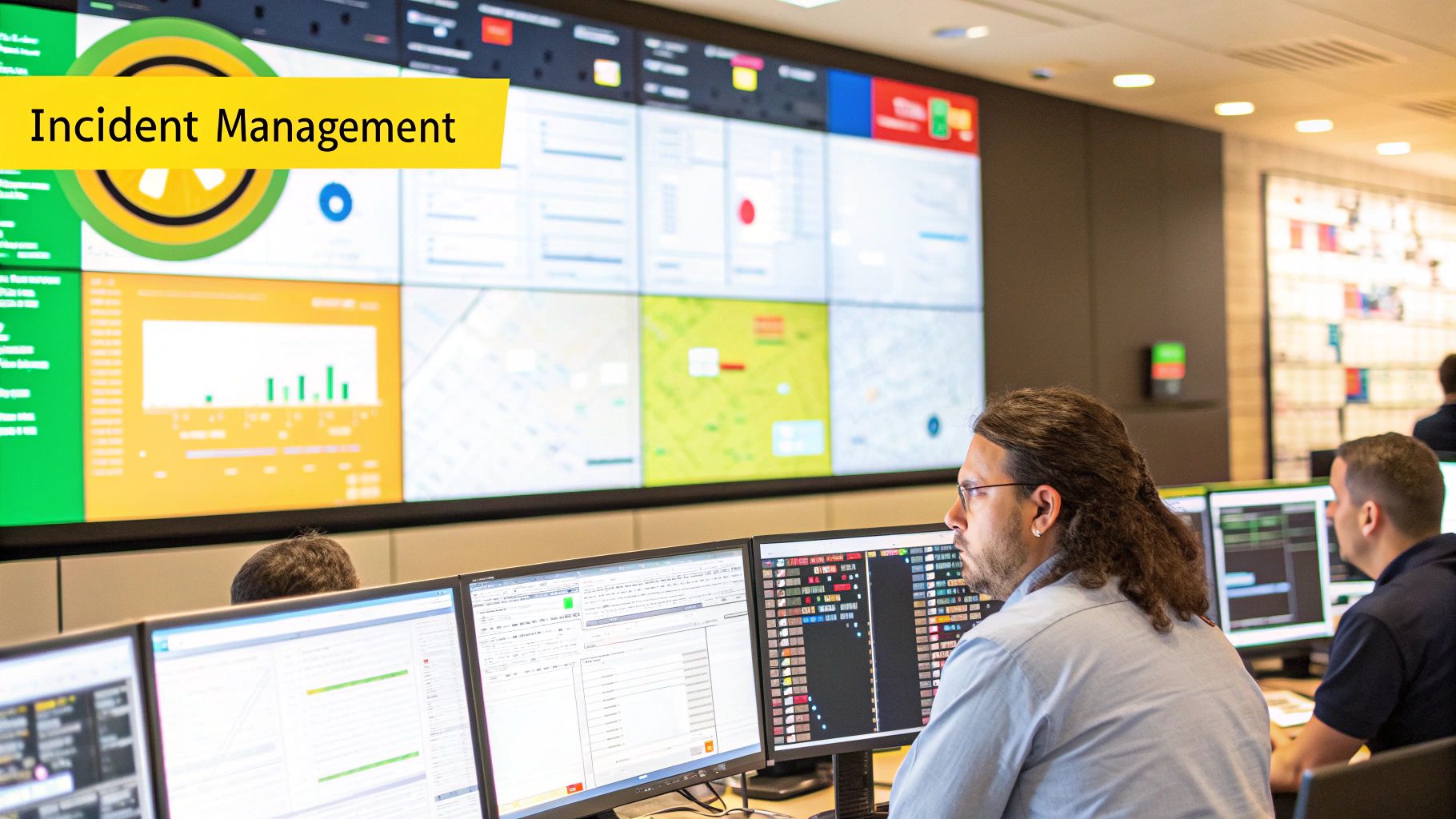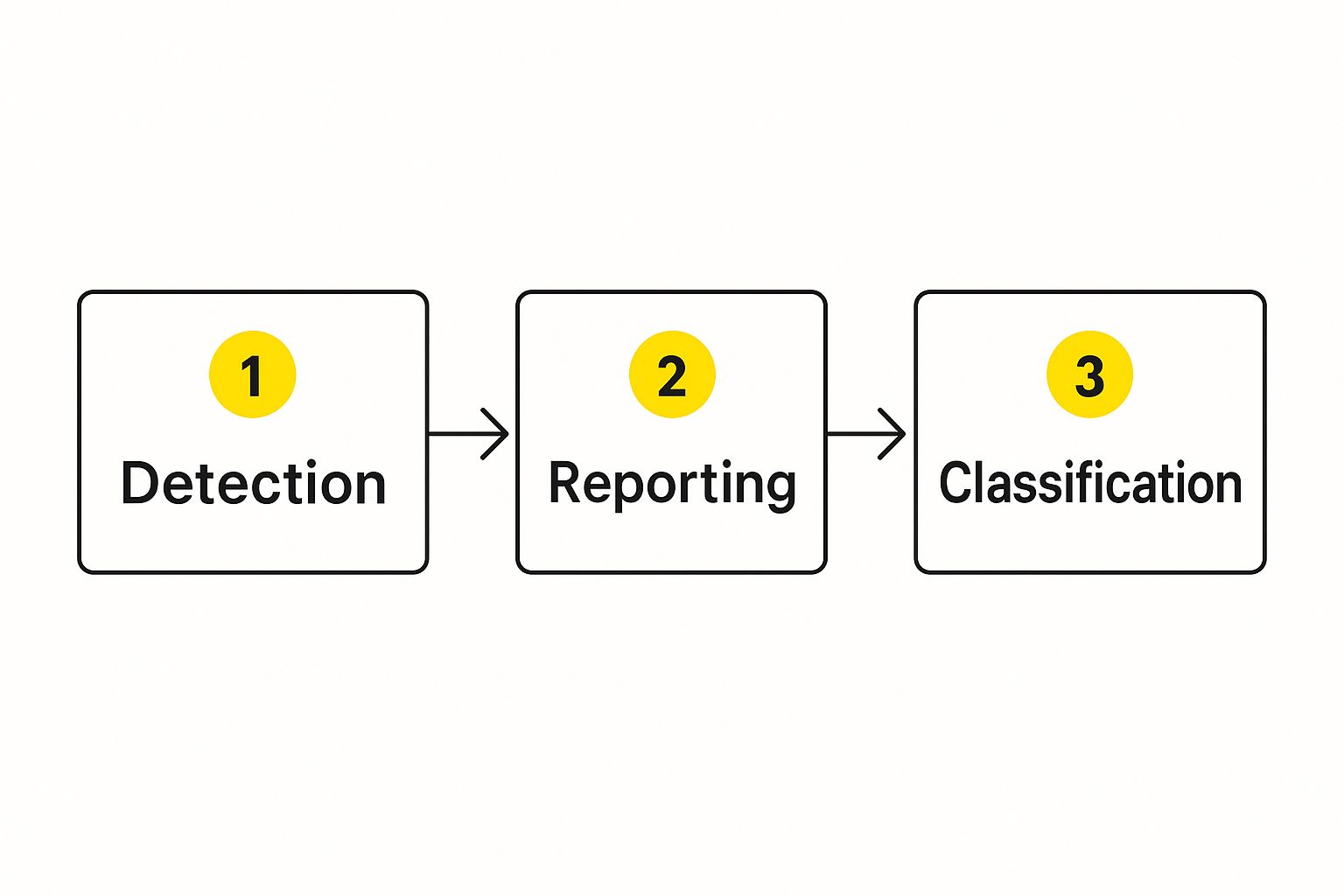Understanding What Makes Incident Management Actually Work

Imagine a busy restaurant kitchen during the dinner rush. Orders pile up, chefs hustle, and even a minor mishap can throw the entire operation into chaos. A well-defined incident management process is like the head chef in this scenario, ensuring every step, from prepping ingredients to serving dishes, runs smoothly. It’s not simply about reacting to problems; it’s about anticipating them and having systems in place to maintain order, even under intense pressure. Understanding the basics of process streamlining is essential for effective incident management.
Key Elements of a Successful Incident Management Process
What separates organizations with mature incident management processes from those constantly fighting fires? Several key elements contribute to this success.
- Clear Roles and Responsibilities: Everyone knows their role and what’s expected of them. This eliminates confusion and speeds up response times.
- Well-Defined Communication Channels: These channels facilitate seamless information flow, preventing misunderstandings and keeping everyone informed.
- Pre-defined Procedures: These “playbooks” outline the steps to take for various types of incidents, ensuring consistent responses. They are invaluable for training new team members and maintaining a high standard of service.
Interestingly, the adoption of comprehensive incident management processes varies significantly across organizations. Only 55% of companies have a fully documented incident response plan as of 2025. Even more concerning, 42% of those with plans don’t update them regularly. This points to a significant gap in preparedness and adaptability. For a deeper dive into these statistics, check out this resource on incident response statistics.
Building a Culture of Proactive Incident Management
Effective incident management isn’t just about having the right tools and processes; it’s about cultivating a culture that values preparedness and learning.
- Regular Training and Simulations: These exercises test procedures and identify weaknesses, ensuring teams are ready for real-world scenarios.
- Blameless Environment: When team members feel safe reporting incidents without fear of blame, it encourages early detection. This prevents small issues from escalating into major crises.
This proactive approach minimizes downtime and fosters continuous improvement. Every incident becomes a valuable learning opportunity. Ultimately, a robust incident management process transforms into a strategic advantage, enabling organizations to navigate disruptions efficiently and emerge stronger.
The Five Phases That Transform Chaos Into Control
Imagine managing an incident like conducting an orchestra during a sudden downpour. Everyone needs their part, their timing, and the ability to adapt when the unexpected happens. This guide walks you through the five crucial phases world-class organizations use to navigate any crisis: Preparation, Detection and Analysis, Containment and Eradication, Recovery, and Post-Incident Learning. Grasping these phases is key to effective incident handling, much like a conductor understanding their score. This incident management workflow offers a helpful breakdown of the key steps.
Preparation: Laying the Groundwork for Success
Just as a conductor studies the score before a concert, preparation is the foundation of a strong incident response. This involves crafting detailed playbooks, establishing crystal-clear communication channels, and defining roles and responsibilities. This groundwork allows teams to react swiftly and decisively when an incident occurs. Think of Netflix and their investment in chaos engineering—they simulate outages to stress-test their systems and refine their responses, much like a dress rehearsal for the real thing.
Detection and Analysis: The Early Warning System
This phase is all about speed—quickly identifying and understanding the incident. Robust monitoring tools and alert systems act as your early warning network, flagging anomalies and potential issues. A quick and precise analysis is crucial, like a doctor diagnosing a patient: the sooner the diagnosis, the faster the treatment begins. The infographic below visualizes these initial stages: detection, reporting, and classification.

This infographic illustrates the importance of a structured approach. Moving from initial detection to formal reporting and then categorization streamlines the process, enabling a quick assessment and efficient allocation of resources. For a deeper dive into best practices, check out these incident management best practices.
Containment and Eradication: Stopping the Bleeding
Once you understand the incident, the focus shifts to damage control and eliminating the root cause. This could involve isolating affected systems, implementing temporary workarounds, or deploying patches. The main goal is to minimize user impact and prevent the incident from spreading. Think of financial institutions and their strict protocols for containing security breaches—they’re designed to protect customer data and maintain trust, like plugging a leak before it floods the building.
Recovery: Getting Back to Normal
Recovery means restoring services to normal operation. But it’s more than just getting systems back online; it involves thorough testing, validation, and clear communication with stakeholders. True recovery restores confidence and ensures the incident doesn’t reappear, like rebuilding after a storm, stronger than before.
Post-Incident Learning: Turning Failure into Growth
This final phase is about learning from the experience to prevent future incidents. It involves conducting a thorough post-mortem analysis, identifying areas for improvement, and updating procedures. This is how organizations evolve and strengthen their incident management process—turning setbacks into opportunities for growth, just like learning a new piece of music after a challenging performance.
To summarize these phases and their key components, let’s look at the following comparison table.
Incident Management Phases Comparison: Detailed breakdown of the five phases showing objectives, key activities, and success metrics for each phase
| Phase | Primary Objective | Key Activities | Success Metrics | Typical Duration |
|---|---|---|---|---|
| Preparation | Establish a foundation for effective incident response | Develop playbooks, define roles and responsibilities, establish communication channels, conduct training and simulations (like chaos engineering at Netflix) | Preparedness level, team familiarity with procedures, effectiveness of communication channels | Ongoing |
| Detection & Analysis | Quickly identify and understand the incident | Monitor systems, trigger alerts, analyze logs and data, diagnose the root cause | Time to detect, time to analyze, accuracy of diagnosis | Minutes to hours |
| Containment & Eradication | Minimize impact and eliminate the root cause | Isolate affected systems, implement workarounds, deploy patches, fix underlying issues | Time to contain, time to eradicate, number of affected users | Hours to days |
| Recovery | Restore services to normal operating conditions | Restore systems, test and validate functionality, communicate with stakeholders | Time to recover, service availability, customer satisfaction | Hours to days |
| Post-Incident Learning | Learn from the incident to prevent future occurrences | Conduct post-mortem analysis, identify areas for improvement, update procedures, implement changes | Number of lessons learned, implementation of corrective actions, reduction in future incidents | Days to weeks |
This table provides a quick overview of the incident management lifecycle, highlighting the interconnectedness of each phase. From proactive preparation to continuous learning, each step plays a vital role in minimizing disruption and maximizing organizational resilience. By understanding and implementing these five phases, you’ll be well-equipped to conduct your incident management “orchestra” even during the most turbulent times.
Building Your Incident Response Dream Team
Effective incident management depends heavily on a well-structured team. Imagine a top-tier surgical team: each member has a specific expertise, but everyone can adapt when the situation changes. This coordinated approach minimizes confusion and maximizes efficiency.
Defining Roles and Responsibilities: Avoiding Decision Paralysis
Clear roles are essential, especially when things get hectic. An incident commander leads the charge, making key decisions and coordinating the team. Technical leads dive into diagnosing and fixing the problem, while communication specialists keep everyone informed. This structure, similar to how Spotify operates, avoids decision paralysis and ensures everyone knows who’s calling the shots. Too many people trying to lead can be just as problematic as not enough.
Balancing Expertise and Communication: The Power of Soft Skills
Technical expertise is a must-have, but clear communication is just as important. The most effective incident response teams understand this balance. Technical leads need to explain complicated issues clearly to non-technical folks, while communication specialists need to grasp the technical details to craft accurate messages. For some helpful advice on improving team dynamics, check out our guide on how to improve team collaboration.
Training and Simulation: Preparing for the Unexpected
Even with the best planning, things can go sideways. Regular training and simulations are key to preparing your team for real incidents. These practice runs allow team members to rehearse their roles, refine communication protocols, and develop the flexibility they’ll need in stressful situations.
Leveraging Technology for Effective Collaboration
Tools like Jira Service Management can significantly improve incident response by centralizing communication, tracking progress, and automating workflows. The screenshot below shows how Jira organizes incident information.

Jira’s visual dashboard gives a clear picture of the incident’s status, who’s working on what, and related tasks. This centralized view helps everyone stay informed and collaborate effectively throughout the process, leading to faster resolution times and better communication. Building your dream incident response team means not only choosing the right people but also giving them the right tools to succeed.
Detection Systems That Actually Catch Problems Early
Imagine your software system is a bustling city. You wouldn’t want to wait for a major power outage to realize there’s a problem with the grid, right? Similarly, robust monitoring systems act as your city’s vigilant watchdogs, alerting you to potential issues before they become full-blown crises. This section explores how to build these early warning systems, drawing on insights from engineering teams at data-heavy organizations. We’ll focus on crafting alerts that provide actionable intelligence, not just a flood of notifications.
The Three-Layer Monitoring Approach
Think of a well-run city with multiple layers of security. Successful companies adopt a similar approach to monitoring, often using these three layers:
- Infrastructure Health: This foundational layer monitors the core components – servers, networks, databases. It’s like checking the city’s power lines and water pipes. Key metrics include CPU usage, disk space, and network latency.
- Application Performance: This layer focuses on how well your software performs its job. Imagine making sure the city’s traffic flows smoothly and buildings operate efficiently. Metrics like response times, error rates, and transaction volumes are crucial here.
- Business Impact Metrics: This top layer connects technical performance to real-world business outcomes. Are customers able to complete purchases? Are users experiencing delays? It’s like checking the city’s overall happiness and productivity levels. This layer tells you if your system is truly serving its purpose.
Balancing Coverage and Alert Fatigue
While comprehensive monitoring is essential, too many alerts can overwhelm your team. Imagine your city’s security system constantly blaring alarms for minor incidents. This alert fatigue can cause your team to miss the truly critical alerts.
The solution lies in prioritizing alerts based on their potential impact. A small increase in CPU usage might be normal, while a sudden surge in error rates warrants immediate attention. It’s about finding the right balance. Interestingly, a substantial number of companies grapple with managing a large volume of incidents. Only about 20% of businesses handle over 20 incidents daily, while almost 70% receive more than 100 alerts each day. For more insights, check out these incident management statistics.
The Power of Context and Predictive Monitoring
Think of a detective solving a case. A single clue rarely reveals the whole story. Similarly, a single alert needs context. Correlating multiple alerts and adding information from other sources like log files and user reports paints a much clearer picture. This helps teams pinpoint the root cause quickly and respond effectively. For more on maintaining smooth IT operations, you might find this helpful: IT Service Continuity Management.
Moreover, machine learning is transforming incident management. Predictive monitoring analyzes past data to spot patterns and forecast potential problems before they impact users. This proactive approach allows you to address underlying issues and strengthen your entire incident management process. It’s like having a city planner who anticipates problems and prevents them before they occur.
Crisis Communication That Builds Trust Instead Of Panic
When systems crash, communication becomes your lifeline. It can either calm the storm or fan the flames of panic. A well-executed communication strategy during an incident can build trust, even when you’re still piecing together the puzzle. Conversely, a poorly handled one can turn a manageable hiccup into a reputational nightmare.
Transparency: The Antidote to Uncertainty
Think of a pilot calmly explaining turbulence to passengers. Even if the air is bumpy, that transparency builds confidence. It’s the same with incident management. Openly acknowledging a problem, even if you haven’t pinpointed the cause yet, shows you’re in control and committed to keeping everyone in the loop. Companies like GitHub and Slack have mastered this, turning transparent incident communication into a powerful tool for customer loyalty. Want to build your own communication plan? Check out this helpful communication plan template.
The Psychology of Calm: Crafting Messages That Inform, Not Alarm
During a crisis, people are hungry for information. But bombarding them with technical details can breed confusion and anxiety. Effective crisis communication means crafting messages that are clear, concise, and focused on what stakeholders need to know. For instance, instead of getting into the weeds of server errors, explain the impact on users and when they can expect things to be back to normal. This approach keeps people informed without overwhelming them with jargon.
Coordinated Communication: Preventing Mixed Messages and Maintaining Credibility
Incident management often involves many teams working at once. Without clear communication protocols, mixed messages can quickly erode trust. Setting up a central communication hub and designating a single spokesperson ensures consistent messaging across all channels. This prevents conflicting information and keeps your credibility intact. Interestingly, whistleblowing and incident management are closely related, with reporting volumes consistently rising. In 2025, online reporting even surpassed traditional hotlines, and case substantiation rates hit a staggering 46%. Learn more about the connection between whistleblowing and incident management.
Communication: The Unsung Hero of Incident Management
Technical expertise is crucial for resolving incidents, no doubt. But communication is often the deciding factor between a smooth recovery and a full-blown crisis. A well-crafted communication strategy soothes anxieties, maintains trust, and ultimately safeguards your organization’s reputation. Investing in your communication plan is an investment in resilience – pure and simple.
Tools That Actually Make Your Life Easier

This screenshot from PagerDuty shows how a clean dashboard can make a real difference in incident management. Imagine having a clear view of all active incidents, their severity, and who’s working on them. This kind of visibility streamlines communication and coordination, which is crucial in those high-pressure moments. Think about a sudden surge of alerts – a good dashboard helps you prioritize the most critical ones, minimizing disruption and getting things back on track quickly. Let’s explore some of the tools that make this possible.
Essential Tools for Streamlining Your Incident Management Process
Choosing the right incident management tools can feel a bit like setting up a workshop. You need the right equipment for the job. A single wrench won’t cut it when you need a full toolkit. Here’s a breakdown of some key players:
- Jira Service Management: Think of Jira Service Management as your central command center. It excels at ticketing, workflow automation, and keeping everyone on the same page. It’s especially valuable for managing the flow of information and tasks during an incident.
- PagerDuty: When every second counts, PagerDuty is your emergency broadcast system. It specializes in alerting and on-call management, ensuring the right people are notified at the right time, no matter the hour.
- Slack: Slack is more than just chat; it’s your virtual war room during an incident. It provides a dedicated space for real-time collaboration, allowing teams to share updates, troubleshoot problems, and coordinate responses quickly and efficiently.
Want to see how automation can streamline other areas of your business? Check out these examples of business process automation. Automating routine tasks frees up your team to focus on the bigger picture – like analyzing the root causes of incidents and preventing them in the future. This brings us to our next topic.
The Emerging Role of AI in Incident Management
Artificial intelligence (AI) is adding a new dimension to incident management. Imagine a system that could predict potential problems before they even happen. That’s the potential of AI. While it’s still early days, AI is already showing promise in areas like:
- Predictive Analytics: AI can analyze historical data, looking for patterns that might predict future incidents. This helps you proactively address vulnerabilities and strengthen your systems.
- Automated Response: For common, routine incidents, AI can automate the initial response, freeing up your team to tackle more complex issues. This speeds up resolution and minimizes downtime.
Choosing the right tools isn’t about jumping on the latest tech bandwagon. It’s about finding solutions that fit your team’s existing workflow and make their lives easier. The best tool is the one your team will actually use. Consider factors like ease of use, how well it integrates with other systems, and whether it’s cost-effective. The goal is to find software that adapts to your team, not the other way around.
To help you choose the right tools, let’s take a look at a comparison of some popular incident management platforms.
Incident Management Tools Comparison
Comprehensive comparison of popular incident management platforms showing features, pricing, and best use cases
| Tool | Key Features | Integration Capabilities | Pricing Model | Best For |
|---|---|---|---|---|
| Jira Service Management | Ticketing, workflow automation, collaboration, reporting | Integrates with other Atlassian products, various APIs | Subscription-based, tiered plans | Teams needing a robust, customizable platform |
| PagerDuty | Alerting, on-call management, escalation policies, incident response automation | Integrations with monitoring tools, chat platforms, ITSM solutions | Subscription-based, based on users and features | Organizations with complex on-call requirements |
| Slack | Real-time communication, channel-based collaboration, file sharing, integrations with other tools | Extensive integrations with various business applications | Free and paid plans, based on features and usage | Teams prioritizing fast communication and collaboration |
This table highlights some key differences between these popular tools. Jira Service Management provides a comprehensive platform for managing the entire incident lifecycle. PagerDuty excels in on-call management and alerting. Slack facilitates real-time communication and collaboration. Choosing the right tool depends on your specific needs and priorities.
By considering these options and focusing on your team’s workflow, you can build an incident management process that’s both effective and efficient.
Turning Every Failure Into Your Next Competitive Advantage
Resilient organizations don’t just fix incidents – they dissect them. They see each failure as a chance to sharpen their incident management process. This proactive approach sets them apart. Let’s explore how to transform post-incident analysis from a routine task into a powerful engine for continuous improvement.
Blameless Post-Mortems: Creating a Culture of Psychological Safety
Imagine a detective at a crime scene. The goal isn’t to point fingers, but to understand why the crime happened. That’s the core of a blameless post-mortem. It’s about creating an environment where teams can openly discuss mistakes without fear.
This psychological safety, championed by companies like Etsy and Google, is vital. When people feel safe, they share valuable insights that might otherwise stay hidden. This openness fuels a culture of learning, resulting in more reliable systems. When choosing tools to support this, consider how process documentation software can help. Good documentation elevates your entire process.
Incident Reports: Telling the Story of Failure
The best incident reports aren’t dry technical documents. They’re narratives. They tell the story of what happened, outlining the timeline, the impact, and the resolution steps.
Think of them as detective stories, complete with clues and a final reveal of the root cause. This engaging format makes learning more effective and helps spread knowledge across the organization. Remember, these narratives should be accessible to everyone, not just technical experts.
From Individual Incidents to Systemic Issues
Individual incidents are often symptoms of bigger problems. A single server failure might reveal a weakness in your infrastructure. A recurring bug could indicate a flaw in your development process.
Post-incident analysis should dig deeper. By identifying these hidden patterns, you can prevent similar incidents. This proactive approach strengthens your whole system and builds resilience.
Actionable Insights: Turning Lessons Learned Into Concrete Improvements
Finding the root cause is just the first step. The real value is in turning lessons learned into concrete actions. This means creating specific, measurable, achievable, relevant, and time-bound (SMART) action items.
These action items should be assigned and tracked. This closes the loop, ensuring every failure leads to improvement. It fosters a culture where sharing failure stories becomes a source of strength.
By treating each failure as a learning opportunity, you create a cycle of improvement. This strengthens your entire organization. Turning setbacks into stepping stones toward greater reliability and resilience is the ultimate goal.
Looking for a tool to facilitate efficient post-incident reviews and drive improvements? Check out resolution’s NASA – Not Another Standup App. It streamlines meeting management, enhances team collaboration, and tracks action items, helping you turn every failure into a valuable learning experience.
